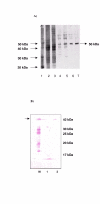Cloning, expression and functional activity of deoxyhypusine synthase from Plasmodium vivax
- PMID: 17042947
- PMCID: PMC1654163
- DOI: 10.1186/1471-2180-6-91
Cloning, expression and functional activity of deoxyhypusine synthase from Plasmodium vivax
Abstract
Background: Plasmodium vivax is the most widespread human malaria parasite. However, genetic information about its pathogenesis is limited at present, due to the lack of a reproducible in vitro cultivation method. Sequencing of the Plasmodium vivax genome suggested the presence of a homolog of deoxyhypusine synthase (DHS) from P. falciparum, the key regulatory enzyme in the first committed step of hypusine biosynthesis. DHS is involved in cell proliferation, and thus a valuable drug target for the human malaria parasite P. falciparum. A comparison of the enzymatic properties of the DHS enzymes between the benign and severe Plasmodium species should contribute to our understanding of the differences in pathogenicity and phylogeny of both malaria parasites.
Results: We describe the cloning of a 1368 bp putative deoxyhypusine synthase gene (dhs) sequence from genomic DNA of P. vivax PEST strain Salvador I (Accession number AJ549098) after touchdown PCR. The corresponding protein was expressed and functionally characterized as deoxyhypusine synthase by determination of its specific activity and cross-reactivity to human DHS on a Western blot. The putative DHS protein from P. vivax displays a FASTA score of 75 relative to DHS from rodent malaria parasite, P. yoelii, and 74 relative to that from the human parasite, P. falciparum strain 3D7. The ORF encoding 456 amino acids was expressed under control of IPTG-inducible T7 promoter, and expressed as a protein of approximately 50 kDa (theoretically 52.7 kDa) in E. coli BL21 DE3 cells. The N-terminal histidine-tagged protein was purified by Nickel-chelate affinity chromatography under denaturing conditions. DHS with a theoretical pI of 6.0 was present in both eluate fractions. The specific enzymatic activity of DHS was determined as 1268 U/mg protein. The inhibitor, N-guanyl-1, 7-diaminoheptane (GC7), suppressed specific activity by 36-fold. Western blot analysis performed with a polyclonal anti-human DHS antibody revealed cross-reactivity to DHS from P. vivax, despite an amino acid identity of 44% between the proteins.
Conclusion: We identify a novel DHS protein in the more benign malaria parasite,P. vivax, on the basis of specific enzymatic activity, cross-reactivity with a polyclonal antibody against human DHS, and amino acid identity with DHS homologs from the rodent malaria parasite, P. yoelii, and human P. falciparum strains.
Figures


Similar articles
-
Modification of eukaryotic initiation factor 5A from Plasmodium vivax by a truncated deoxyhypusine synthase from Plasmodium falciparum: An enzyme with dual enzymatic properties.Bioorg Med Chem. 2007 Sep 15;15(18):6200-7. doi: 10.1016/j.bmc.2007.06.026. Epub 2007 Jun 14. Bioorg Med Chem. 2007. PMID: 17591443
-
Target evaluation of deoxyhypusine synthase from Theileria parva the neglected animal parasite and its relationship to Plasmodium.Bioorg Med Chem. 2014 Aug 1;22(15):4338-46. doi: 10.1016/j.bmc.2014.05.007. Epub 2014 May 21. Bioorg Med Chem. 2014. PMID: 24909679
-
An experimental target-based platform in yeast for screening Plasmodium vivax deoxyhypusine synthase inhibitors.PLoS Negl Trop Dis. 2024 Dec 2;18(12):e0012690. doi: 10.1371/journal.pntd.0012690. eCollection 2024 Dec. PLoS Negl Trop Dis. 2024. PMID: 39621767 Free PMC article.
-
The biology of Plasmodium vivax explored through genomics.Ann N Y Acad Sci. 2015 Apr;1342(1):53-61. doi: 10.1111/nyas.12708. Epub 2015 Feb 18. Ann N Y Acad Sci. 2015. PMID: 25693446 Free PMC article. Review.
-
Spermidine metabolism in parasitic protozoa--a comparison to the situation in prokaryotes, viruses, plants and fungi.Folia Parasitol (Praha). 2003 Mar;50(1):3-18. doi: 10.14411/fp.2003.002. Folia Parasitol (Praha). 2003. PMID: 12735718 Review.
Cited by
-
The Role of Spermidine and Its Key Metabolites in Important, Pathogenic Human Viruses and in Parasitic Infections Caused by Plasmodium falciparum and Trypanosoma brucei.Biomolecules. 2023 May 9;13(5):803. doi: 10.3390/biom13050803. Biomolecules. 2023. PMID: 37238673 Free PMC article. Review.
-
In vitro and in vivo silencing of plasmodial dhs and eIf-5a genes in a putative, non-canonical RNAi-related pathway.BMC Microbiol. 2012 Jun 13;12:107. doi: 10.1186/1471-2180-12-107. BMC Microbiol. 2012. PMID: 22694849 Free PMC article.
-
The guanylhydrazone CNI-1493: an inhibitor with dual activity against malaria-inhibition of host cell pro-inflammatory cytokine release and parasitic deoxyhypusine synthase.Parasitol Res. 2008 May;102(6):1177-84. doi: 10.1007/s00436-008-0891-x. Epub 2008 Feb 7. Parasitol Res. 2008. PMID: 18256853
-
Deoxyhypusine hydroxylase from Plasmodium vivax, the neglected human malaria parasite: molecular cloning, expression and specific inhibition by the 5-LOX inhibitor zileuton.PLoS One. 2013;8(3):e58318. doi: 10.1371/journal.pone.0058318. Epub 2013 Mar 7. PLoS One. 2013. PMID: 23505486 Free PMC article.
-
Cryptosporidium parvum has an active hypusine biosynthesis pathway.Mol Biochem Parasitol. 2014 Jun;195(1):14-22. doi: 10.1016/j.molbiopara.2014.05.005. Epub 2014 Jun 2. Mol Biochem Parasitol. 2014. PMID: 24893338 Free PMC article.
References
Publication types
MeSH terms
Substances
Associated data
- Actions
LinkOut - more resources
Full Text Sources
Research Materials
Miscellaneous

